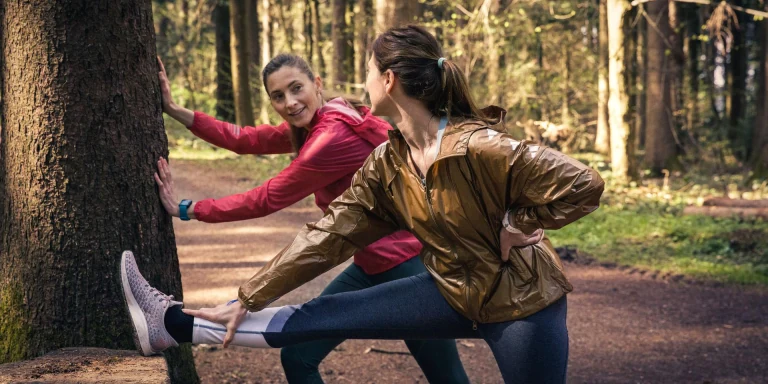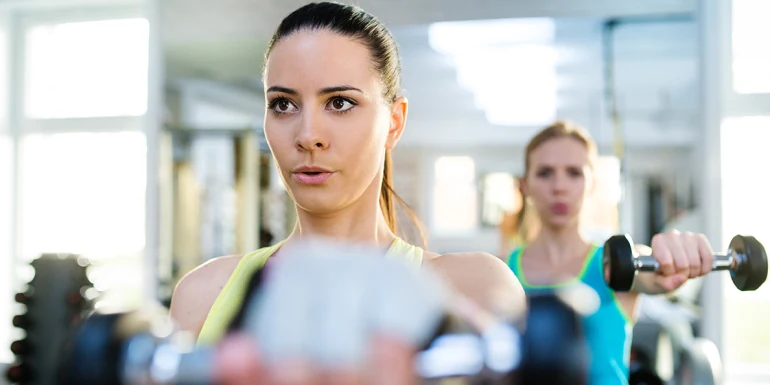
Tips for getting more exercise in your daily life
Modern life often means that we don’t get enough exercise. We spend long periods sitting and don’t walk enough. However, it’s worth including regular exercise in your daily routine, as this improves our well-being and strengthens our immune system.
Doing regular exercise has numerous benefits: you’re doing your health some good and strengthening your immune system. You sleep better, are not as stressed and your performance improves. Furthermore, exercise makes you feel happy and increases your self-esteem.
When we do physical activity, our bodies release dopamine, serotonin and endorphins, known as “happiness hormones”. When you exercise regularly, the concentration of them increases permanently and not just during physical exertion. You become more awake and content. When exercising, cortisone, a stress hormone, is also released. However, over the long-term, exercise can reduce the level of cortisol. We become more tolerant of stress, both physically and mentally.
Overview of topics
Introduce more exercise into your daily routine
The first step towards a more active everyday life is including more exercise. This is easy to achieve and doesn’t take much effort. However, it has a big impact, as even short periods of exercise keep you mentally and physically fit. For example, you can change the following habits:
- Take the stairs rather than the lift or escalator.
- Walk or cycle short distances.
- Get off the bus or tram one stop earlier and walk the rest of the way.
- Make phone calls and hold short meetings standing up.
- Take a break to move around every now and then during your workday.
- Give preference to hobbies that involve you being active.
- Meet up with friends for a walk or do something active.
Turn exercise into a routine
Do you want to be more active and include more exercise in your everyday life? Look for a type of exercise that you enjoy and that meets your requirements. This will make it easier to keep at it.
- Endurance: jogging, cycling, swimming, trampolining
- Strength and fitness: strength training, group fitness
- Team sports: football, basketball, floorball, ice hockey, handball, volleyball, rugby
- Relaxation: yoga, t’ai chi, Pilates
- Fun and action: mountain biking, bouldering, slacklining, skateboarding, skiing, snowboarding, tobogganing
- Water sports: swimming, rowing, surfing, snorkelling, sailing, diving
- In the great outdoors: walking, Nordic walking, jogging, hiking, climbing, mountaineering, horse riding, cycling, bootcamps, winter sports, orienteering
- Music: dancing, Zumba, aqua fitness, gymnastics
- With friends: badminton, tennis, squash, table tennis, in-line skating, tandem, golf, Frisbee
- Competitive sports: martial arts, fencing, Swiss wrestling
- Other ideas: gymnastics, Hornussen (traditional Swiss sport), ice-skating, curling
Inspiration in the Helsana Coach app
In the Helsana Coach app, you can find different strength, endurance, flexibility and yoga workouts. Get inspired for your next training session with one of our ideas. You can also add an entire programme to your plan. Helsana Coach will then accompany you on the way to achieving your health goals.
How to get and stay motivated
Start with small steps.
If you make exercise and physical activity part of your everyday routine, they’ll soon become a habit. Don’t put yourself under pressure. Take it easy and follow our tips and you’ll enjoy exercising in no time.
Finding the right type of exercise
Try a type of exercise that you like and that makes you happy. Remind yourself why exercise is important for your health and quality of life.
Listen to your body.
Pay attention to the messages your body is sending you. Your body will tell you whether the goals you’re aiming for are appropriate or if you’re overdoing it. Don’t set the bar too high. It’ll save you from getting frustrated.
Find people who want the same thing.
Exercising as part of a group is more motivating: hiking, cycling or playing badminton together is fun and easy to organise.
Set yourself reasonable goals.
Sensible goals are SMART goals:
- S = specific
- M = measurable
- A = attractive
- R = realistic
- T = timed
Make a goal that is as specific as possible. Make sure that it is measurable. Set a goal that you can motivate yourself to achieve. Be ambitious but realistic. And define when you would like to achieve your goal.
Make a plan
Put fixed dates for exercise in your diary and consciously take time for it.
Fitness trackers can motivate you to do more physical activity and therefore improve your training and fitness. Most trackers count your steps and calculate your calorie consumption. They measure your pulse and heart rate, and some have an integrated GPS.
The optimal amount of exercise
The more active you are, the greater the benefits for your health. The right amount depends on your physical condition and age. Generally, nobody needs to fear regularly quickening their pulse a little.
Babies should have the opportunity to move freely several times a day, in an age-appropriate environment, as this promotes their natural urge to move. Small children and pre-school aged children need to be physically active for at least three hours a day. The intensity of the activities does not matter.
Younger children generally enjoy moving and you shouldn’t set them any limits. They notice themselves when they’ve had enough. Young people should do at least one hour of exercise a day with several moderate and higher intensity sessions a week. Moderate means being slightly out of breath, while higher intensity should get you working up a sweat. Ideally, young people should follow a varied exercise programme with playful elements to train their strength and endurance while increasing their flexibility and dexterity.
For adults, the aim is to improve stamina and strengthen the muscles. They should do at least two and a half hours of moderate intensity exercise every week, such as stair climbing, brisk walking or cycling. If you have less time to spare, you can do one and a quarter hours a week at a higher intensity, i.e. you should work up a slight sweat. Either way, it is recommended that you spread your activities over several days of the week.
If the pregnancy has been problem free, two and half hours of exercise per week at a medium intensity is generally recommended. Women that were active before their pregnancy can do their usual exercise routines for as long they feel able to do so.
Exercise keeps older people mobile for longer, and enables them to have an independent life. Try to do at least two and a half hours of moderately intense physical activity or one and a quarter hours of high intensity exercise every week. This does not mean you have to strive to keep up with top athletes, though. Brisk walks, cycling or walking to the shops, gardening or swimming a few lengths of the pool are efficient everyday training methods, and all of them improve stamina and flexibility.

The specialist provided the editorial team with advice and input for this article. Evelyne Dürr (Msc in Human Movement Sciences, ETH; CAS workplace health promotion) was working for Helsana’s health consultation service at the time the article was written.


Newsletter
Find out more about current health issues every month and get all the information you need about our attractive offers from all Helsana Group companies * delivered by e-mail to read whenever it suits you. Our newsletter is free of charge and you can sign up here:
We did not receive your information. Please try again later.
* The Helsana Group comprises Helsana Insurance Company Ltd, Helsana Supplementary Insurances Ltd and Helsana Accidents Ltd.
